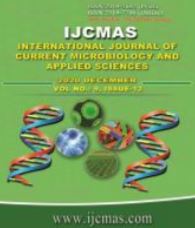


 National Academy of Agricultural Sciences (NAAS)
National Academy of Agricultural Sciences (NAAS)

|
PRINT ISSN : 2319-7692
Online ISSN : 2319-7706 Issues : 12 per year Publisher : Excellent Publishers Email : editorijcmas@gmail.com / submit@ijcmas.com Editor-in-chief: Dr.M.Prakash Index Copernicus ICV 2018: 95.39 NAAS RATING 2020: 5.38 |
The present study was conducted in purposively selected Jalna district of Marathwada region of Maharashtra state as it is having highest area under grapes cultivation. From the district, four major grape growing villages identified and from each village 30 grape growers were selected which constitute 120 respondents. Ex-post facto research design was used for the investigation. The results of profile of the grape growers revealed that, majority of the grape growers were middle aged (68.33%), had secondary level educated (41.67%), were medium experience of grape cultivation (71.67%), had semi- medium land holding (43.33%), had medium area under grape (89.17%), medium annual income (75.83%), most of them had low level of social participation (52.50%), using medium sources of information (68.33%), most of them had medium level of economic motivation (85.00%), had medium level of knowledge (82.50%), most of them had medium level of risk orientation (74.17%) and innovativeness (58.34%). As regards to the relational analysis it is observed that, independent variables like education and knowledge of grape growers established positive and highly significant association with adoption of safety measures in pesticide application and experience in grape cultivation, annual income, sources of information, economic motivation, risk orientation and innovativeness of the grape growers had found to be positive and significant with their adoption. While land holding, area under grape and social participation of grape growers had found non-significant relationship with adoption and age was negatively significant with adoption.
 |
 |
 |
 |
 |